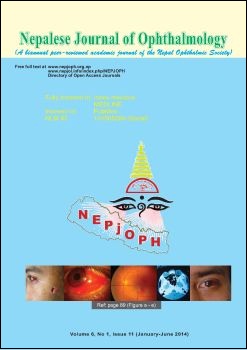Factors affecting the time lag to the second eye cataract surgery in a hospital-based population
DOI:
https://doi.org/10.3126/nepjoph.v6i1.10761Keywords:
cataract surgery, barriers, sequential cataract extractionAbstract
Introduction: Cataract can be treated successfully, yet patients delay surgery. Surgery in one eye may not promote surgery in the second.
Objectives: To determine the time lag to the second eye cataract surgery and identify the factors that affect it.
Materials and methods: This study was conducted at an ophthalmology out-patient department of a teaching hospital and was an observational, cross-sectional study. Consecutive patients of over 45 years who had had cataract surgery in one eye and had visually significant senile cataract in the other were categorized into those that requested sequential surgery (Group 1) and those that refused (Group 2). The relevant history and vision were recorded. A questionnaire was used to seek possible responsible factors that determined the refusal for the second surgery.
Statistical analysis: Categorical variables were compared between groups using the chi-square test and continuous variables using the Student t-test. Factors significantly affecting the time lag were subjected to the analysis of covariance.
Rresults: Of the 250 patients of the study, only 104 (41.6 %) requested the second eye surgery, less than one-fifth within one year. Thirteen patients from Group 2 presented with complications of hypermaturity in the second eye. The average time lag was 2.39 ± 2.19 years. It was significantly more in Group 2 patients (p = 0.024) who also reported more barriers (2.75 ± 1.23 versus 1.58 ± 1.10; p = 0.005). The factors that increased the time lag were older age (p = 0.028), extra-capsular surgery (p < 0.001), and being able to manage after the first surgery (p = 0.011) in Group1, and eye-camp (p = 0.021) or extra-capsular surgery (p < 0.001) in Group 2 patients.
Conclusions: One-fifth of the patients reported back for sequential surgery within one year. Patients who refused surgery had more barriers; most were related to the first surgery and should be anticipated by compassionate ophthalmic professionals after surgery in the first eye.
DOI: http://dx.doi.org/10.3126/nepjoph.v6i1.10761
Nepal J Ophthalmol 2014; 6 (2): 31-38
Downloads
Downloads
Published
How to Cite
Issue
Section
License
This license enables reusers to copy and distribute the material in any medium or format in unadapted form only, for noncommercial purposes only, and only so long as attribution is given to the creator.




